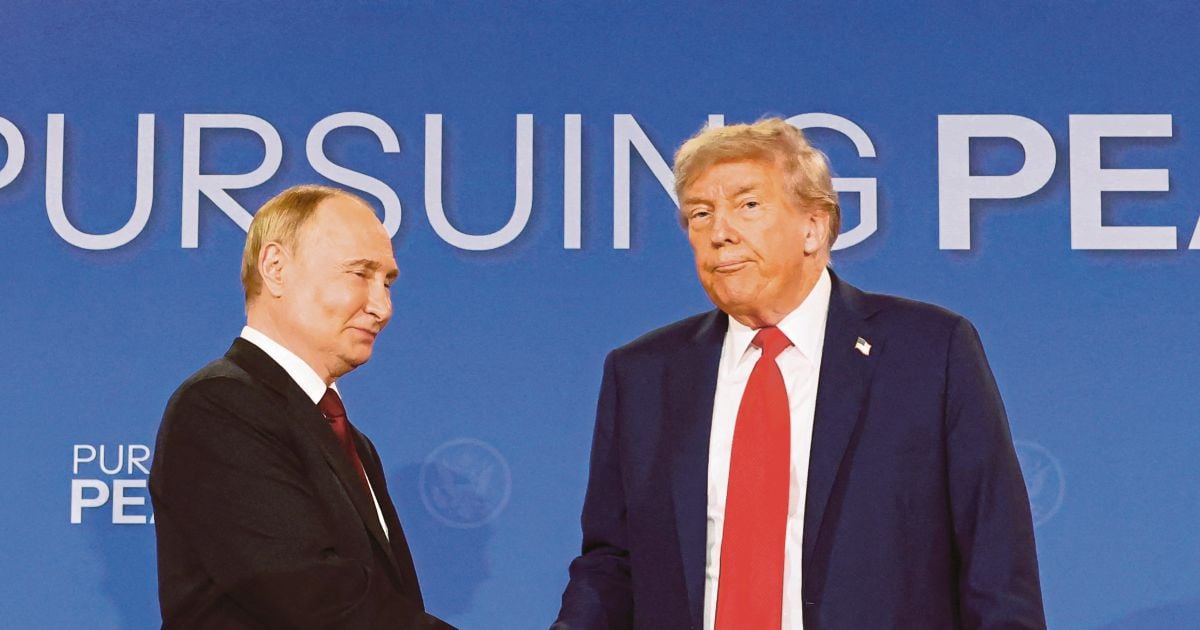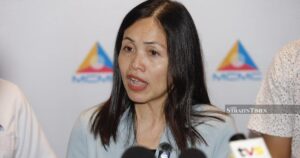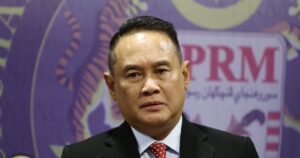SETTING foot on Western soil for the first time since he ordered the invasion of Ukraine, Vladimir Putin basked in choreographed pageantry courtesy of Donald Trump, but was also confronted by signs of American power.
In made-for-television images, Putin and Trump each flew in their presidential planes to Elmendorf Air Base, the largest US military installation in Alaska that played a key role in monitoring the Soviet Union.
Trump waited in Air Force One until Putin landed and then stepped down to the tarmac, clapping as he saw the Russian leader for the first time since 2019, this time under a frigid slate-grey sky.
They then walked towards each other, smiled and shook hands before posing together on a stage that read “Alaska 2025”.
In a highly unusual move, Putin stepped in “The Beast”, the ultra-secure US presidential limousine, alongside Trump before they headed into talks that focused on Ukraine.
Putin grinned widely and appeared to joke to reporters as the two met in a room which the American hosts emblazoned with the words — written only in English — “Pursuing Peace”.
Putin sought to flatter Trump, speaking to him of how he wanted a positive relationship and — seizing on one of the US leader’s favourite themes — agreeing that he would not have invaded Ukraine if Trump and not Joe Biden were president in 2022.
When Trump told Putin of how he hoped to meet again, the Russian leader broke out rare words of English: “Next time in Moscow.”
The reception was a striking contrast to a White House meeting with Ukrainian President Volodymyr Zelenskyy in February, when Trump and Vice President J.D. Vance berated him and accused him of ingratitude.
Zelenskyy was long hailed across the Western world.
Putin by contrast has curtailed his travel sharply since he sent troops to invade Ukraine, and he faces an arrest warrant from the International Criminal Court related to the war.
Putin was quickly confronted on the war as a reporter repeatedly and loudly shouted out to him, “When will you stop killing civilians?”
Putin did not react.
Both sides sought to press their message, sometimes in unsubtle ways.
As Putin walked in, a B-2 stealth bomber — an ultimate symbol of US military power — flew overhead.
Sergei Lavrov, the veteran Russian foreign minister rarely seen out of a jacket and tie, was photographed arriving ahead of Putin in Alaska in a sweatshirt emblazoned with “CCCP” — the USSR — in a reminder of the superpower status that Putin has been striving to recreate.
Senior Russian officials were temporarily relieved from severe US sanctions in place since the Ukraine invasion, allowing them not just to arrive in the US but to carry out day-to-day transactions such as withdrawing money from cash machines.
Putin and Trump did not step off the base, but activists held out hope of at least a fleeting protest by posting blue-and-yellow Ukrainian flags on roofs that could be spotted if either leader looked out of his plane’s windows.
With just a week to prepare since Trump announced the summit, Anchorage was strained to capacity with hotels full of tourists on fishing expeditions and coastal cruises who had no warning that their summer destination would become the focus of global diplomacy.
Russian journalists, unable to secure accommodation, posted disapproving pictures of staying at a sports arena, where they slept on cots partitioned off from one another by black curtains.
The US hosts served the Russian journalists a selection of familiar foods — shashlik meat skewers, grilled fish and, in a common dish for Russians that suddenly could take on another meaning, chicken Kiev.
* The writer is from AFP
© New Straits Times Press (M) Bhd






